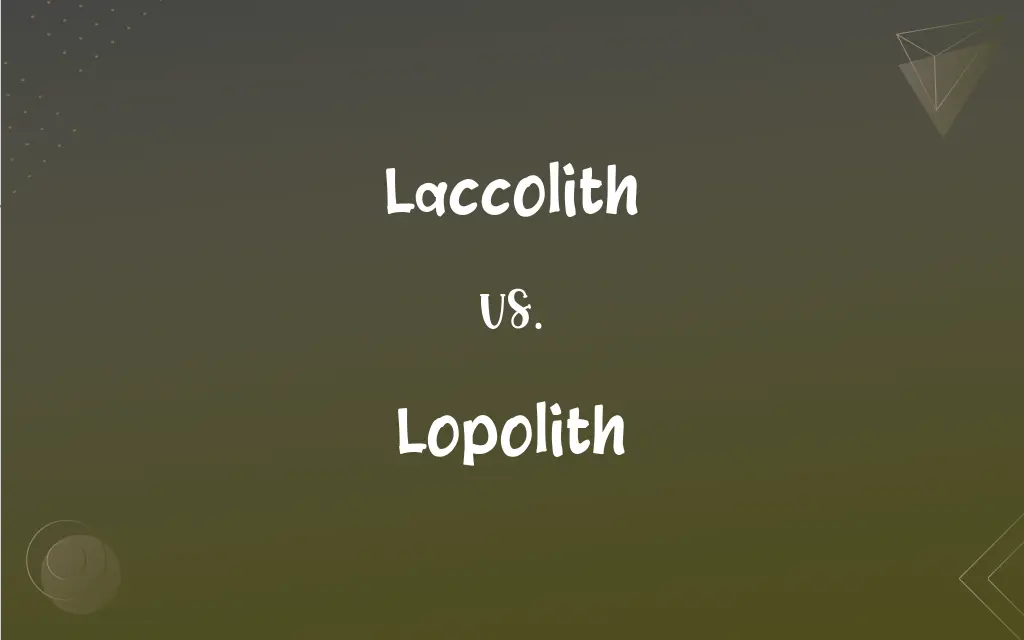Laccolith vs. Lopolith: What's the Difference?
By Harlon Moss & Aimie Carlson || Updated on May 21, 2024
A laccolith is a dome-shaped intrusion of magma between rock layers, causing the overlying strata to bulge upwards, while a lopolith is a saucer-shaped intrusion of magma that causes the overlying strata to sag downwards.

Key Differences
A laccolith is formed when magma intrudes between layers of sedimentary rock, creating a dome-like structure as the pressure from the magma forces the overlying layers to bulge upward. This type of igneous intrusion typically results in a convex upward formation and is often relatively small in scale. A lopolith, on the other hand, is created when magma intrudes in a manner that causes the overlying rock layers to sag downward, forming a concave, saucer-like shape.
While laccoliths push upwards, creating a dome, lopoliths cause a downward depression, creating a saucer-shaped feature. Laccoliths are usually found at shallower depths compared to lopoliths, which can be found at greater depths and involve larger volumes of magma.
In terms of their formation, laccoliths result from relatively viscous magma that doesn't travel far from the point of intrusion, leading to localized uplift. Lopoliths form from magma that spreads out over a larger area, causing the overlying rock to sag due to the weight and spread of the intrusion.
Comparison Chart
Shape
Dome-shaped, convex upward
Saucer-shaped, concave downward
Formation Process
Magma intrudes, pushing layers upward
Magma intrudes, causing layers to sag
ADVERTISEMENT
Typical Depth
Shallower
Deeper
Size
Relatively small
Usually larger
Magma Movement
Limited, localized uplift
Spread over a larger area
Geological Impact
Uplift of overlying strata
Sagging of overlying strata
Laccolith and Lopolith Definitions
Laccolith
A dome-shaped igneous intrusion.
The laccolith caused a noticeable bulge in the terrain.
ADVERTISEMENT
Lopolith
A saucer-shaped igneous intrusion.
The lopolith caused the ground to sag in a broad area.
Laccolith
Magma intruded between sedimentary layers.
The geologists studied the laccolith to understand its formation.
Lopolith
Magma intruded, causing downward sagging.
The sagging layers were evidence of a lopolith below.
Laccolith
Usually smaller in scale compared to other intrusions.
The small hill was identified as a laccolith.
Lopolith
Usually larger and deeper than laccoliths.
The vast lopolith impacted a significant geological area.
Laccolith
Forms a convex upward structure.
The mountain range was partly shaped by an underlying laccolith.
Lopolith
Forms a concave downward structure.
The geologists mapped the lopolith's extensive reach.
Laccolith
Results in localized uplift.
The uplifted layers indicated the presence of a laccolith.
Lopolith
Results in extensive sagging.
The basin-like depression was due to a large lopolith.
Laccolith
A mass of igneous rock intruded between layers of sedimentary rock, resulting in uplift.
Lopolith
A large, bowl-shaped body of igneous rock intruded between layers of sedimentary rock.
Laccolith
(geology) A mass of igneous or volcanic rock found within strata which forces the overlaying strata upwards and forms domes.
Lopolith
(geology) a mass of volcanic or igneous rock found within strata which has spilled downward into underlaying strata and forms depressed regions.
Laccolith
A mass similar to lopolith but concave up.
Lopolith
(geology) mass similar to laccolith but concave down
FAQs
How does a lopolith form?
It forms when magma spreads out and causes the overlying rock layers to sag.
What shape does a laccolith have?
Dome-shaped and convex upward.
Is a lopolith shallow or deep?
Usually found at greater depths.
What shape does a lopolith have?
Saucer-shaped and concave downward.
What type of magma movement creates a laccolith?
Localized and limited uplift of magma.
What is a lopolith?
A saucer-shaped igneous intrusion formed by magma causing rock layers to sag downward.
What is a laccolith?
A dome-shaped igneous intrusion formed by magma pushing rock layers upward.
How does a laccolith form?
It forms when magma intrudes between sedimentary layers, causing them to bulge upward.
What impact does a laccolith have on the terrain?
Causes uplift and bulging of the overlying strata.
Can laccoliths be identified by their shape?
Yes, by their dome-like, convex upward shape.
Is a laccolith shallow or deep?
Typically shallow compared to lopoliths.
Where are laccoliths typically found?
In areas with sedimentary rock layers at shallow depths.
Do laccoliths cause localized or widespread geological changes?
Localized uplift.
What size is a typical laccolith?
Relatively small in scale.
What impact does a lopolith have on the terrain?
Causes sagging and depression of the overlying strata.
Do lopoliths cause localized or widespread geological changes?
Widespread sagging and depression.
What size is a typical lopolith?
Often larger than laccoliths.
Can lopoliths be identified by their shape?
Yes, by their saucer-like, concave downward shape.
What type of magma movement creates a lopolith?
Spread of magma over a larger area, causing sagging.
Where are lopoliths typically found?
At greater depths with larger magma intrusions.
About Author
Written by
Harlon MossHarlon is a seasoned quality moderator and accomplished content writer for Difference Wiki. An alumnus of the prestigious University of California, he earned his degree in Computer Science. Leveraging his academic background, Harlon brings a meticulous and informed perspective to his work, ensuring content accuracy and excellence.
Co-written by
Aimie CarlsonAimie Carlson, holding a master's degree in English literature, is a fervent English language enthusiast. She lends her writing talents to Difference Wiki, a prominent website that specializes in comparisons, offering readers insightful analyses that both captivate and inform.































































